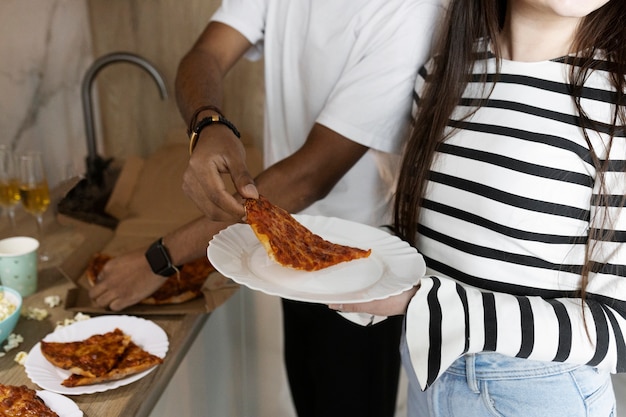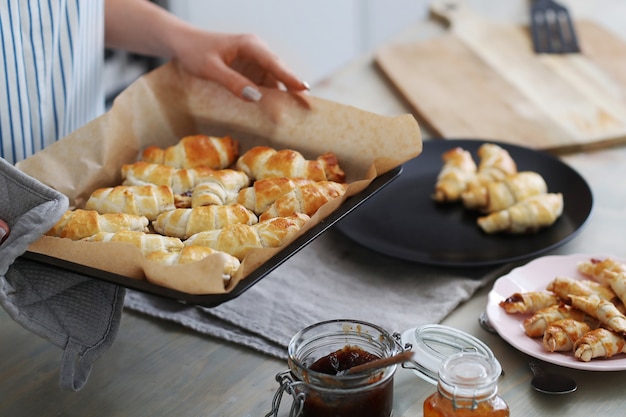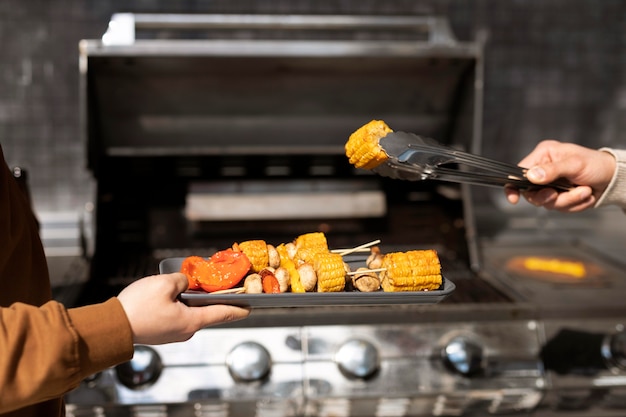chicken tenders are a classic for a reason. They're a blank canvas for flavour, quick to cook, and always a hit with everyone from kids to adults. But let's be honest, sometimes you just want those crispy, juicy, perfectly cooked tenders, and the stovetop is the best way to get them.
Over the years, I've tried a bunch of different methods – from deep-frying to baking – but nothing quite compares to the satisfaction of a perfectly cooked stovetop chicken tender. It's about getting that golden-brown crust, that tender, juicy inside, and of course, avoiding any dry, rubbery bits.
Today, I'm going to share my secrets for achieving that stovetop perfection, so grab a notepad and get ready to cook!
(Part 1) Choosing Your Chicken Tenders

The journey to delicious chicken tenders starts with picking the right ingredients. You might think all chicken tenders are created equal, but there's a bit more to it than that.
Finding the Right Cut
I've learned the hard way that a slightly thicker cut of chicken tender is going to be your best friend on the stovetop. Those thin, flimsy tenders are prone to drying out quickly. Look for ones with a bit of girth to them, because they'll hold up better in the pan and give you a more satisfying bite.
Frozen or Fresh?
Let's be real, sometimes we just need those convenient frozen chicken tenders. But when you have the time, fresh ones are definitely worth the extra effort. The flavour is more vibrant, and the texture is just a bit nicer.
Thawing Your Chicken Tenders
If you're working with frozen tenders, thawing them properly is crucial. The microwave is a big no-no – it'll turn your chicken into a rubbery mess. The best way is to let them thaw slowly in the fridge overnight. This gives them a chance to thaw evenly, preserving their juiciness.
(Part 2) Preparing the Chicken Tenders

Alright, your tenders are chosen, now it's time to get them ready for their stovetop transformation.
The Importance of Patting Dry
This might seem like a minor detail, but patting your chicken tenders dry with paper towels is absolutely essential. This helps the breading adhere properly and prevents them from steaming instead of crisping up.
Seasoning the Chicken
Now, this is where you can really express your culinary creativity! You can stick to the classics like salt, pepper, and a touch of garlic powder. But don't be afraid to experiment. A sprinkle of paprika, a pinch of cayenne, or a blend of herbs can give your chicken tenders a whole new dimension of flavor.
A Note on Seasoning
I personally love to add a little bit of smoked paprika to my breading, just a touch to give it a subtle smokiness that really complements the chicken.
(Part 3) The Breadcrumb Dilemma

The breading is the key to that perfect crispy crust. But with so many choices, it can feel a little overwhelming.
Choosing Your Breadcrumbs
Plain breadcrumbs, panko, seasoned breadcrumbs – the options seem endless! It really comes down to personal preference, but my go-to is panko. Its coarse texture gives those amazing, crunchy bits.
The Art of Breadcrumbing
This is the part where you transform those naked chicken tenders into crispy masterpieces. I like to use three bowls: one for flour, one for a whisked egg mixture with a splash of milk, and one for breadcrumbs. The milk in the egg mixture helps the breading cling to the chicken better.
Gently dredge each chicken tender in the flour, coating it evenly.
Dip the flour-coated tender into the egg mixture, making sure it's fully coated.
Finally, press the tender into the breadcrumbs, ensuring it's fully covered.
(Part 4) The Stovetop Showdown
Now for the main event! It's time to bring out your trusty skillet and create those beautiful, golden chicken tenders.
Choosing the Right Pan
You'll want a large skillet with a heavy base. Cast iron is a great choice because it distributes heat evenly, but a good-quality non-stick pan will also do the trick.
Heating the Oil
This is the part where it gets a bit tricky. You want your oil hot, but not smoking. I usually add about ?? inch of oil to the pan and heat it over medium-high heat. You'll know it's ready when a drop of water sizzles and pops.
Adding the Chicken Tenders
Don't overcrowd the pan! This can lead to steaming instead of frying, which we definitely want to avoid. Work in batches if needed. Gently lay the breaded tenders in the hot oil and let them cook undisturbed for about 3-4 minutes per side. You want to achieve that golden-brown crust and ensure the chicken is cooked through.
A Word on Oil
I usually use vegetable oil or canola oil, as they have a neutral flavor and a high smoke point, which is crucial for frying.
(Part 5) The Finish Line
Your chicken tenders are sizzling away, but how do you know when they're ready?
Checking for Doneness
The best way to ensure your tenders are cooked through is with a meat thermometer. It should register 165 degrees Fahrenheit. If you don't have one, you can always cut open a tender and check if the juices run clear.
Resting the Chicken Tenders
Once your tenders are cooked to perfection, take them out of the pan and let them rest on a wire rack for a few minutes. This allows the juices to redistribute, ensuring a juicy and tender bite.
(Part 6) Sauce It Up!
No chicken tender is complete without a delicious dipping sauce. This is where you can truly let your taste buds run wild!
Dipping Sauce Delights
The classic ketchup is always a winner, but there's a world of possibilities out there. Creamy honey mustard, tangy bbq sauce, fiery buffalo sauce – the choices are endless.
Homemade Sauce Hacks
If you're feeling adventurous, try making your own sauce. A simple mayonnaise-based dip with a bit of lemon juice, fresh herbs, and spices is a delicious and easy option.
My Go-To Sauce
I've got a little trick for a quick and easy sauce that I always keep in my fridge. Just mix equal parts mayonnaise and sour cream, add a pinch of garlic powder, some freshly chopped dill, and a squeeze of lemon juice. It's tangy, creamy, and incredibly versatile.
(Part 7) The Ultimate Chicken Tender Experience
Your chicken tenders are cooked, rested, and ready to be devoured. Now, how do you make them even more amazing?
Serving Up Success
I love to serve my chicken tenders with a simple side of chips and a refreshing coleslaw. The crispness of the chips and the cool, tangy coleslaw complement the chicken perfectly.
Leftover Love
The best part about chicken tenders? They're even better the next day! They're perfect in sandwiches, wraps, or even on a salad.
(Part 8) Troubleshooting Your Stovetop Journey
No matter how experienced a cook you are, sometimes things don't go exactly as planned. Here are a few common stovetop chicken tender hiccups and how to fix them.
Burnt Breadcrumbs
This happens to the best of us. If your breadcrumbs are burning too quickly, turn the heat down a little. Make sure you're not overcrowding the pan, and give those tenders a little more space to cook evenly.
Soggy Tenders
If your tenders are coming out soggy, you might be using too much oil. Also, make sure your oil is hot enough before adding the chicken. If the oil isn't hot enough, the chicken will start to steam instead of fry.
Dry Tenders
If your tenders are dry, you might have overcooked them. Try cooking them for a shorter time and check for doneness with a meat thermometer. Remember, it's better to err on the side of slightly undercooked than overcooked, as you can always cook them a bit longer if needed.
FAQs
What is the best oil to use for cooking chicken tenders on the stovetop?
I recommend using a high-heat oil, like vegetable oil or canola oil. They have a neutral flavor and a high smoke point, which is important for frying. avocado oil is another good option, as it has a higher smoke point and a slightly more buttery flavor.
Can I use other types of chicken for this recipe?
Absolutely! You can use chicken breasts, thighs, or even drumsticks. Just make sure to adjust the cooking time accordingly. Thicker pieces of chicken will need a bit longer to cook through.
How long can I keep cooked chicken tenders in the fridge?
Cooked chicken tenders will keep in the fridge for 3-4 days. Just make sure to store them in an airtight container.
Can I freeze cooked chicken tenders?
Yes, you can freeze cooked chicken tenders. Freeze them in an airtight container or freezer bag for up to 2 months. Thaw them in the refrigerator overnight before reheating.
What are some other ways to cook chicken tenders besides stovetop?
You can also bake, fry, or air fry chicken tenders. Each method has its own unique advantages and disadvantages. Baking is a good option for a healthier choice, while frying can give you that extra crispy texture. Air frying is a faster and more convenient option, but it can sometimes dry out the chicken if you're not careful.
I hope this guide has inspired you to try your hand at cooking perfect chicken tenders on the stovetop. Remember, practice makes perfect, so don't be afraid to experiment and find what works best for you. Happy cooking!
Everyone is watching

How to Cook Frozen Lobster Tails Perfectly: A Step-by-Step Guide
RecipesLobster. Just the word conjures up images of lavish meals, special occasions, and a taste of luxury. But let's...

Pigs in a Blanket Cooking Time: How Long to Bake for Perfect Results
RecipesAh, pigs in a blanket. Just the name conjures up images of those delightful little parcels of crispy pastry en...

Pork Fillet Cooking Time: How Long to Cook It Perfectly
RecipesPork fillet, or tenderloin as it's sometimes called, is a real favourite in our house. It's so versatile, and...

The Ultimate Guide to Tender, Juicy Pulled Pork
RecipesRight, let's talk pulled pork. It's one of those dishes that just screams "comfort food," doesn't it? I mean...

The Ultimate Guide to Cooking Delicious Frankfurters
RecipesLet's face it, we all love a good frankfurter. It's a classic, simple, and always satisfying. But let's be rea...
